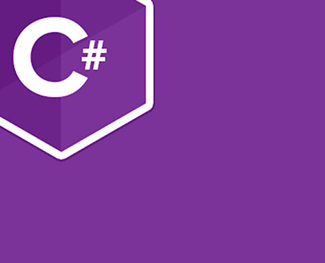Thêm, sửa, xóa học sinh trong C# Winforms
Ở bài viết trước mình đã thực hiện hiển thị danh sách học sinh và tìm kiếm trong C# Winforms. Tiếp theo đó, mình sẽ hướng dẫn cách thêm, sửa, xóa học sinh trong C# Winforms ở bài viết này, các bạn hãy cùng mình tìm hiểu thôi nhé.

1. Tạo giao diện form thêm, sửa, xóa học sinh trong C# winforms
Việc đầu tiên chúng ta cần tạo form thêm, sửa, xóa học sinh trong C# Winforms, cụ thể như sau:
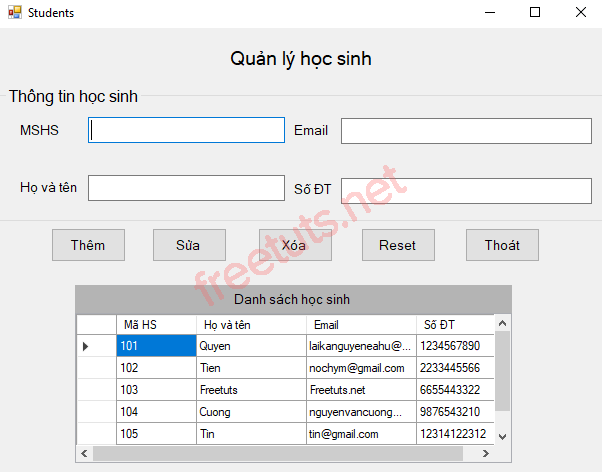
Trong form có một số control quan trọng:
- Các TextBox: Để người dùng nhập thông tin và hiển thị thông tin khi người dùng chọn vào bảng dữ liệu.
- Button "Thêm": Thêm mới học sinh vào database khi người dùng nhập đầy đủ các thông tin.
- Button "Sửa": Thay đổi dữ liệu trong database bằng dữ liệu mà người dùng nhập vào ở các ô TextBox.
- Button "Xóa": Xóa hàng dữ liệu mà người dùng chọn khỏi database.
- Button "Reset": Xóa các thông tin đang hiển thị trên TextBox.
- Button "Thoát": Hiển thị hộp thoại yêu cầu người dùng xác nhận có muốn thoát hay không.
- DataGridView: Hiển thị danh sách các user ngay khi chương trình bắt đầu chạy.
*Lưu ý: Mỗi khi người dùng thao tác xong thì cần làm mới lại bảng dữ liệu.
Bài viết này được đăng tại [free tuts .net]
2. Tạo database và Stored Procedure trong SQL
Trong chương trình này mình sử dụng database StudentDB, các bạn có thể tạo mới hoặc sử dụng đoạn code sau để tạo database.
CREATE DATABASE StudentDB; GO USE StudentDB; GO CREATE TABLE Student( Id INT PRIMARY KEY, Name VARCHAR(100), Email VARCHAR(50), Mobile VARCHAR(50) ) GO INSERT INTO Student VALUES (101, 'Quyen', '[email protected]', '1234567890') INSERT INTO Student VALUES (102, 'Tien', '[email protected]', '2233445566') INSERT INTO Student VALUES (103, 'Freetuts', 'Freetuts.net', '6655443322') INSERT INTO Student VALUES (104, 'Cuong', '[email protected]', '9876543210') GO
Tiếp đến ta cần tạo một số Stored Procedure trong SQL Server.
Proc hiển thị danh sách học sinh.
create proc [dbo].[SP_Retrieve_Student] as begin select * from Student end
Proc thêm mới học sinh.
create proc [dbo].[SP_ThemHocSinh] @Ten nvarchar(50), @Email nvarchar(50), @Mobile nvarchar(50) as begin insert into Student values (@Ten,@Email,@Mobile) end
Proc sửa học sinh.
create proc [dbo].[SP_SuaHocSinh] @MaHS int, @Ten nvarchar(50), @Email nvarchar(50), @Mobile nvarchar(50) as begin update Student set Name = @Ten, Email = @Email, Mobile = @Mobile where Id = @MaHS end
Proc xóa học sinh.
create proc [dbo].[SP_XoaHocSinh] @MaHS int as begin delete Student where Id = @MaHS end
3. Thêm, sửa, xóa học sinh trong C# winforms
Sau khi đã tạo giao diện form và chuẩn bị database, proc thì bây bắt đầu vào việc viết sự kiện cho các control.
Hiển thị danh sách học sinh vào DataGridView
Để có thể sử dụng nhiều lần, mình sẽ viết một hàm LayDSHS() dùng để hiển thị danh sách học sinh từ SQL Server vào DataGridView.
private void LayDSHS()
{
//khởi tạo các đối tượng SqlConnection, SqlDataAdapter, DataTable
SqlConnection conn = new SqlConnection();
SqlDataAdapter da = new SqlDataAdapter();
DataTable dt = new DataTable();
//lấy chuỗi kết nối từ file App.config
conn.ConnectionString = ConfigurationManager.ConnectionStrings["conStr"].ConnectionString;
try
{
//mở chuỗi kết nối
conn.Open();
//khai báo đối tượng SqlCommand trong SqlDataAdapter
da.SelectCommand = new SqlCommand();
//gọi thủ tục từ SQL
da.SelectCommand.CommandText = "SP_Retrieve_Student";
da.SelectCommand.CommandType = CommandType.StoredProcedure;
//gán chuỗi kết nối
da.SelectCommand.Connection = conn;
//sử dụng phương thức fill để điền dữ liệu từ datatable vào SqlDataAdapter
da.Fill(dt);
//gán dữ liệu từ datatable vào datagridview
dtgDSHS.DataSource = dt;
//đóng chuỗi kết nối
conn.Close();
//sử dụng thuộc tính Width và HeaderText để set chiều dài và tiêu đề cho các coloumns
dtgDSHS.Columns[0].Width = 80;
dtgDSHS.Columns[0].HeaderText = "Mã HS";
dtgDSHS.Columns[1].Width = 110;
dtgDSHS.Columns[1].HeaderText = "Họ và tên";
dtgDSHS.Columns[2].Width = 110;
dtgDSHS.Columns[2].HeaderText = "Email";
dtgDSHS.Columns[3].Width = 90;
dtgDSHS.Columns[3].HeaderText = "Số ĐT";
}
catch (Exception ex)
{
MessageBox.Show(ex.Message);
}
}Sau đó gọi hàm ở sự kiện form_Load.
private void Students_Load(object sender, EventArgs e)
{
LayDSHS();
}Kết quả:

Xử lý sự kiện cho button "Reset"
Mình sẽ viết một hàm Reset() để xóa các thông tin đang hiển thị trên TextBox. Khi các thao tác được thực hiện xong thì sẽ gọi hàm này và xóa các thông tin trên TextBox đi.
private void Reset()
{
txtEmail.Text = "";
txtMSHS.Text = "";
txtSDT.Text = "";
txtTen.Text = "";
}
public void btnReset_Click(object sender, EventArgs e)
{
Reset();
}Xử lý sự kiện cho button "Thêm"
Để chắc rằng các thông tin người dùng nhập vào đầy đủ, mình sẽ viết một hàm kiểm tra xem các thông tin được nhập đầy đủ hay chưa.
public bool KTThongTin()
{
if(txtTen.Text == "")
{
MessageBox.Show("Vui lòng nhập tên học sinh", "Thông báo", MessageBoxButtons.OK, MessageBoxIcon.Information);
txtTen.Focus();
return false;
}
if (txtEmail.Text == "")
{
MessageBox.Show("Vui lòng nhập email học sinh", "Thông báo", MessageBoxButtons.OK, MessageBoxIcon.Information);
txtEmail.Focus();
return false;
}
if (txtSDT.Text == "")
{
MessageBox.Show("Vui lòng nhập SĐT học sinh", "Thông báo", MessageBoxButtons.OK, MessageBoxIcon.Information);
txtSDT.Focus();
return false;
}
return true;
}Sau đó gọi Proc "SP_ThemHocSinh" để thêm mới học sinh với các thông tin ở TextBox mà người dùng đã nhập.
private void btnThem_Click(object sender, EventArgs e)
{
if (KTThongTin())
{
try
{
SqlConnection conn = new SqlConnection();
conn.ConnectionString = ConfigurationManager.ConnectionStrings["conStr"].ConnectionString;
SqlCommand cmd = new SqlCommand();
cmd.CommandText = "SP_ThemHocSinh";
cmd.CommandType = CommandType.StoredProcedure;
cmd.Parameters.Add("@Ten", SqlDbType.NVarChar).Value = txtTen.Text;
cmd.Parameters.Add("@Email", SqlDbType.NVarChar).Value = txtEmail.Text;
cmd.Parameters.Add("@Mobile", SqlDbType.NVarChar).Value = txtSDT.Text;
cmd.Connection = conn;
conn.Open();
cmd.ExecuteNonQuery();
conn.Close();
LayDSHS();
Reset();
MessageBox.Show("Đã thêm mới học sinh thành công", "Thông báo", MessageBoxButtons.OK, MessageBoxIcon.Information);
}
catch (Exception ex)
{
MessageBox.Show(ex.Message);
}
}
}Kết quả:
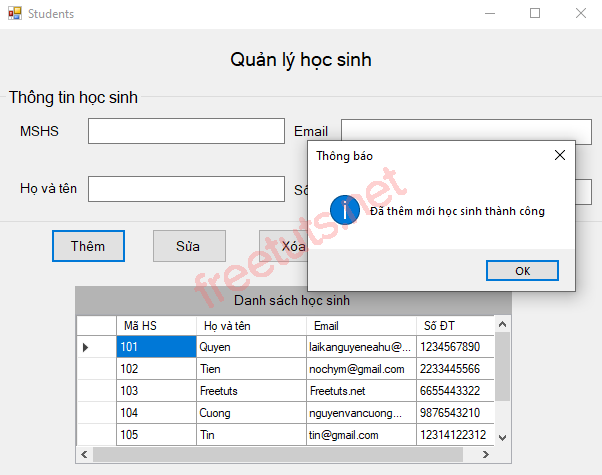
Xử lý sự kiện CellClick trên DataGridView.
Khi người dùng chọn vào hàng dữ liệu trên DataGridView, thì các dữ liệu sẽ được hiển thị trên các ô TextBox tương ứng.
private void dtgDSHS_CellClick(object sender, DataGridViewCellEventArgs e)
{
DataGridViewRow row = new DataGridViewRow();
row = dtgDSHS.Rows[e.RowIndex];
txtMSHS.Text = Convert.ToString(row.Cells["Id"].Value);
txtTen.Text = Convert.ToString(row.Cells["Name"].Value);
txtEmail.Text = Convert.ToString(row.Cells["Email"].Value);
txtSDT.Text = Convert.ToString(row.Cells["Mobile"].Value);
}Xử lý sự kiện cho button "Sửa"
Tương tự như thêm mới học sinh, ta chỉ cần thêm một tham số MaHS để làm điều kiện thay đổi, cùng với đó là sử dụng proc "SP_SuaHocSinh" trong SQL Server.
Để sửa được thông tin ta có thể sử dụng một trong hai cách. Cách thứ nhất chọn vào hàng dữ liệu sau đó thay đổi thông tin muốn sửa. Cách thứ hai là nhập trực tiếp vào các ô TextBox.
private void btnSua_Click(object sender, EventArgs e)
{
if (txtMSHS.Text == "")
{
MessageBox.Show("Vui lòng nhập mã học sinh cần sửa", "Thông báo", MessageBoxButtons.OK, MessageBoxIcon.Information);
txtMSHS.Focus();
}
else if (KTThongTin())
{
try
{
SqlConnection conn = new SqlConnection();
conn.ConnectionString = ConfigurationManager.ConnectionStrings["conStr"].ConnectionString;
SqlCommand cmd = new SqlCommand();
cmd.CommandText = "SP_SuaHocSinh";
cmd.CommandType = CommandType.StoredProcedure;
cmd.Parameters.Add("@MaHS", SqlDbType.Int).Value = Convert.ToInt32(txtMSHS.Text);
cmd.Parameters.Add("@Ten", SqlDbType.NVarChar).Value = txtTen.Text;
cmd.Parameters.Add("@Email", SqlDbType.NVarChar).Value = txtEmail.Text;
cmd.Parameters.Add("@Mobile", SqlDbType.NVarChar).Value = txtSDT.Text;
cmd.Connection = conn;
conn.Open();
cmd.ExecuteNonQuery();
conn.Close();
LayDSHS();
Reset();
MessageBox.Show("Đã sửa học sinh thành công", "Thông báo", MessageBoxButtons.OK, MessageBoxIcon.Information);
}
catch (Exception ex)
{
MessageBox.Show(ex.Message);
}
}
}Kết quả:
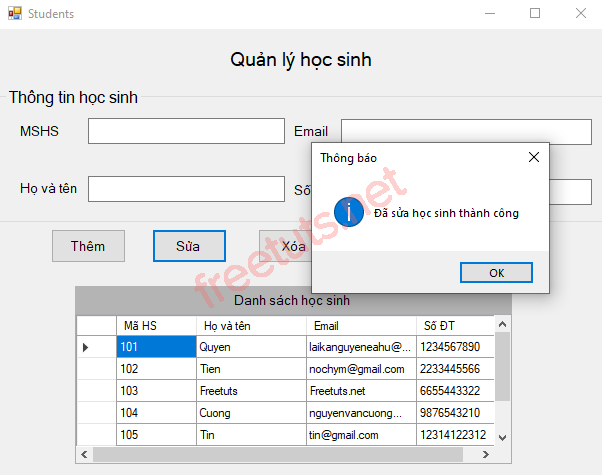
Xử lý sự kiện cho button "Xóa"
Ở sự kiện xóa thì ta chỉ cần một tham số đó là "MaHS", vì là khóa chính nên chỉ cần xóa học sinh có mã này mà không cần thêm thông tin khác. Ta sẽ sử dụng proc SP_XoaHocSinh trong SQL Server mình đã viết ở phần thứ hai.
private void btnXoa_Click(object sender, EventArgs e)
{
if (txtMSHS.Text == "")
{
MessageBox.Show("Vui lòng nhập mã học sinh cần xóa", "Thông báo", MessageBoxButtons.OK, MessageBoxIcon.Information);
txtMSHS.Focus();
}
else
{
try
{
SqlConnection conn = new SqlConnection();
conn.ConnectionString = ConfigurationManager.ConnectionStrings["conStr"].ConnectionString;
SqlCommand cmd = new SqlCommand();
cmd.CommandText = "SP_XoaHocSinh";
cmd.CommandType = CommandType.StoredProcedure;
cmd.Parameters.Add("@MaHS", SqlDbType.Int).Value = Convert.ToInt32(txtMSHS.Text);
cmd.Connection = conn;
conn.Open();
cmd.ExecuteNonQuery();
conn.Close();
LayDSHS();
Reset();
MessageBox.Show("Đã xóa học sinh thành công", "Thông báo", MessageBoxButtons.OK, MessageBoxIcon.Information);
}
catch (Exception ex)
{
MessageBox.Show(ex.Message);
}
}
}Kết quả:
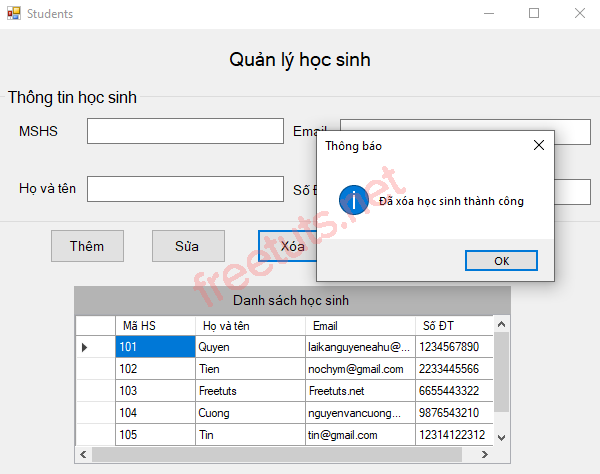
Xử lý sự kiện cho button "Thoát"
Để chắc chắn người dùng muốn thoát, ta sử dụng DialogResult để lấy kết quả mà người dùng chọn từ hộp thoại MessageBox. Nếu người dùng chọn OK thì thoát khỏi chương trình, ngược lại sẽ hủy bỏ lệnh
private void btnThoat_Click(object sender, EventArgs e)
{
DialogResult dg = MessageBox.Show("Bạn có chắc muốn thoát?","Thông báo", MessageBoxButtons.OKCancel,MessageBoxIcon.Question);
if(dg == DialogResult.OK)
{
Application.Exit();
}
}Kết quả:
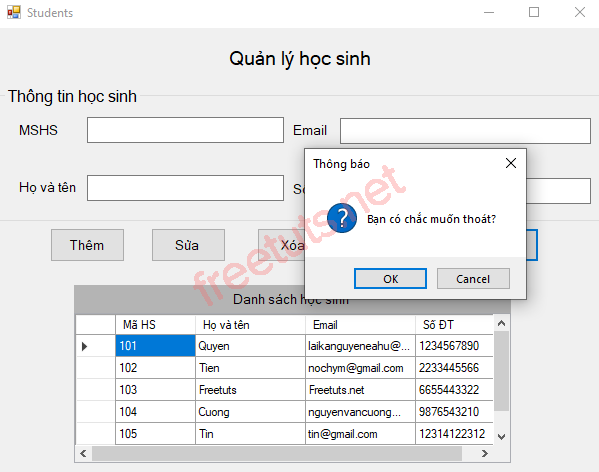
4. Code hoàn chỉnh thêm, sửa, xóa học sinh trong C# Winforms
using System;
using System.Collections.Generic;
using System.ComponentModel;
using System.Configuration;
using System.Data;
using System.Data.SqlClient;
using System.Drawing;
using System.Linq;
using System.Text;
using System.Threading.Tasks;
using System.Windows.Forms;
namespace ExampleStudent
{
public partial class Students : Form
{
public Students()
{
InitializeComponent();
}
private void Students_Load(object sender, EventArgs e)
{
LayDSHS();
}
private void LayDSHS()
{
//khởi tạo các đối tượng SqlConnection, SqlDataAdapter, DataTable
SqlConnection conn = new SqlConnection();
SqlDataAdapter da = new SqlDataAdapter();
DataTable dt = new DataTable();
//lấy chuỗi kết nối từ file App.config
conn.ConnectionString = ConfigurationManager.ConnectionStrings["conStr"].ConnectionString;
try
{
//mở chuỗi kết nối
conn.Open();
//khai báo đối tượng SqlCommand trong SqlDataAdapter
da.SelectCommand = new SqlCommand();
//gọi thủ tục từ SQL
da.SelectCommand.CommandText = "SP_Retrieve_Student";
da.SelectCommand.CommandType = CommandType.StoredProcedure;
//gán chuỗi kết nối
da.SelectCommand.Connection = conn;
//sử dụng phương thức fill để điền dữ liệu từ datatable vào SqlDataAdapter
da.Fill(dt);
//gán dữ liệu từ datatable vào datagridview
dtgDSHS.DataSource = dt;
//đóng chuỗi kết nối
conn.Close();
//sử dụng thuộc tính Width và HeaderText để set chiều dài và tiêu đề cho các coloumns
dtgDSHS.Columns[0].Width = 80;
dtgDSHS.Columns[0].HeaderText = "Mã HS";
dtgDSHS.Columns[1].Width = 110;
dtgDSHS.Columns[1].HeaderText = "Họ và tên";
dtgDSHS.Columns[2].Width = 110;
dtgDSHS.Columns[2].HeaderText = "Email";
dtgDSHS.Columns[3].Width = 90;
dtgDSHS.Columns[3].HeaderText = "Số ĐT";
}
catch (Exception ex)
{
MessageBox.Show(ex.Message);
}
}
private void btnThoat_Click(object sender, EventArgs e)
{
DialogResult dg = MessageBox.Show("Bạn có chắc muốn thoát?","Thông báo", MessageBoxButtons.OKCancel,MessageBoxIcon.Question);
if(dg == DialogResult.OK)
{
Application.Exit();
}
}
private void Reset()
{
txtEmail.Text = "";
txtMSHS.Text = "";
txtSDT.Text = "";
txtTen.Text = "";
}
public void btnReset_Click(object sender, EventArgs e)
{
Reset();
}
public bool KTThongTin()
{
if(txtTen.Text == "")
{
MessageBox.Show("Vui lòng nhập tên học sinh", "Thông báo", MessageBoxButtons.OK, MessageBoxIcon.Information);
txtTen.Focus();
return false;
}
if (txtEmail.Text == "")
{
MessageBox.Show("Vui lòng nhập email học sinh", "Thông báo", MessageBoxButtons.OK, MessageBoxIcon.Information);
txtEmail.Focus();
return false;
}
if (txtSDT.Text == "")
{
MessageBox.Show("Vui lòng nhập SĐT học sinh", "Thông báo", MessageBoxButtons.OK, MessageBoxIcon.Information);
txtSDT.Focus();
return false;
}
return true;
}
private void btnThem_Click(object sender, EventArgs e)
{
if (KTThongTin())
{
try
{
SqlConnection conn = new SqlConnection();
conn.ConnectionString = ConfigurationManager.ConnectionStrings["conStr"].ConnectionString;
SqlCommand cmd = new SqlCommand();
cmd.CommandText = "SP_ThemHocSinh";
cmd.CommandType = CommandType.StoredProcedure;
cmd.Parameters.Add("@Ten", SqlDbType.NVarChar).Value = txtTen.Text;
cmd.Parameters.Add("@Email", SqlDbType.NVarChar).Value = txtEmail.Text;
cmd.Parameters.Add("@Mobile", SqlDbType.NVarChar).Value = txtSDT.Text;
cmd.Connection = conn;
conn.Open();
cmd.ExecuteNonQuery();
conn.Close();
LayDSHS();
Reset();
MessageBox.Show("Đã thêm mới học sinh thành công", "Thông báo", MessageBoxButtons.OK, MessageBoxIcon.Information);
}
catch (Exception ex)
{
MessageBox.Show(ex.Message);
}
}
}
private void txtMSHS_Enter(object sender, EventArgs e)
{
if (txtMSHS.Text == "Thêm mới không cần nhập")
{
txtMSHS.Clear();
txtMSHS.ForeColor = SystemColors.Highlight;
}
}
private void txtMSHS_Leave(object sender, EventArgs e)
{
if (txtMSHS.Text == "")
{
txtMSHS.Text = "Thêm mới không cần nhập";
txtMSHS.ForeColor = SystemColors.InactiveCaption;
}
}
private void dtgDSHS_CellClick(object sender, DataGridViewCellEventArgs e)
{
DataGridViewRow row = new DataGridViewRow();
row = dtgDSHS.Rows[e.RowIndex];
txtMSHS.Text = Convert.ToString(row.Cells["Id"].Value);
txtTen.Text = Convert.ToString(row.Cells["Name"].Value);
txtEmail.Text = Convert.ToString(row.Cells["Email"].Value);
txtSDT.Text = Convert.ToString(row.Cells["Mobile"].Value);
}
private void btnSua_Click(object sender, EventArgs e)
{
if (txtMSHS.Text == "")
{
MessageBox.Show("Vui lòng nhập mã học sinh cần sửa", "Thông báo", MessageBoxButtons.OK, MessageBoxIcon.Information);
txtMSHS.Focus();
}
else if (KTThongTin())
{
try
{
SqlConnection conn = new SqlConnection();
conn.ConnectionString = ConfigurationManager.ConnectionStrings["conStr"].ConnectionString;
SqlCommand cmd = new SqlCommand();
cmd.CommandText = "SP_SuaHocSinh";
cmd.CommandType = CommandType.StoredProcedure;
cmd.Parameters.Add("@MaHS", SqlDbType.Int).Value = Convert.ToInt32(txtMSHS.Text);
cmd.Parameters.Add("@Ten", SqlDbType.NVarChar).Value = txtTen.Text;
cmd.Parameters.Add("@Email", SqlDbType.NVarChar).Value = txtEmail.Text;
cmd.Parameters.Add("@Mobile", SqlDbType.NVarChar).Value = txtSDT.Text;
cmd.Connection = conn;
conn.Open();
cmd.ExecuteNonQuery();
conn.Close();
LayDSHS();
Reset();
MessageBox.Show("Đã sửa học sinh thành công", "Thông báo", MessageBoxButtons.OK, MessageBoxIcon.Information);
}
catch (Exception ex)
{
MessageBox.Show(ex.Message);
}
}
}
private void btnXoa_Click(object sender, EventArgs e)
{
if (txtMSHS.Text == "")
{
MessageBox.Show("Vui lòng nhập mã học sinh cần xóa", "Thông báo", MessageBoxButtons.OK, MessageBoxIcon.Information);
txtMSHS.Focus();
}
else if (KTThongTin())
{
try
{
SqlConnection conn = new SqlConnection();
conn.ConnectionString = ConfigurationManager.ConnectionStrings["conStr"].ConnectionString;
SqlCommand cmd = new SqlCommand();
cmd.CommandText = "SP_XoaHocSinh";
cmd.CommandType = CommandType.StoredProcedure;
cmd.Parameters.Add("@MaHS", SqlDbType.Int).Value = Convert.ToInt32(txtMSHS.Text);
cmd.Connection = conn;
conn.Open();
cmd.ExecuteNonQuery();
conn.Close();
LayDSHS();
Reset();
MessageBox.Show("Đã xóa học sinh thành công", "Thông báo", MessageBoxButtons.OK, MessageBoxIcon.Information);
}
catch (Exception ex)
{
MessageBox.Show(ex.Message);
}
}
}
}
}
Trên đây là cách thêm, sửa, xóa học sinh trong C# Winforms. Ở các bài tiếp theo mình sẽ thực hành các bài tập C# Winforms với CSDL SQL Server, các bạn chú ý theo dõi nhé !!!

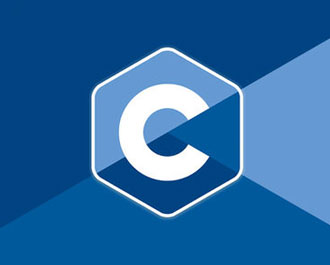 Các kiểu dữ liệu trong C ( int - float - double - char ...)
Các kiểu dữ liệu trong C ( int - float - double - char ...)  Thuật toán tìm ước chung lớn nhất trong C/C++
Thuật toán tìm ước chung lớn nhất trong C/C++  Cấu trúc lệnh switch case trong C++ (có bài tập thực hành)
Cấu trúc lệnh switch case trong C++ (có bài tập thực hành)  ComboBox - ListBox trong lập trình C# winforms
ComboBox - ListBox trong lập trình C# winforms 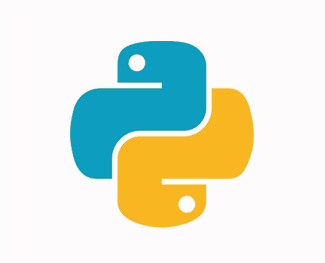 Random trong Python: Tạo số random ngẫu nhiên
Random trong Python: Tạo số random ngẫu nhiên 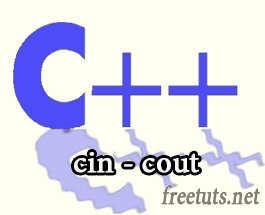 Lệnh cin và cout trong C++
Lệnh cin và cout trong C++  Cách khai báo biến trong PHP, các loại biến thường gặp
Cách khai báo biến trong PHP, các loại biến thường gặp  Download và cài đặt Vertrigo Server
Download và cài đặt Vertrigo Server 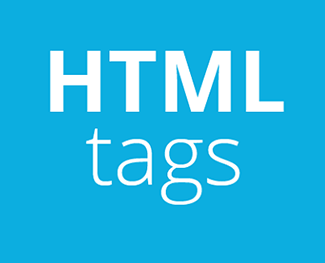 Thẻ li trong HTML
Thẻ li trong HTML  Thẻ article trong HTML5
Thẻ article trong HTML5  Cấu trúc HTML5: Cách tạo template HTML5 đầu tiên
Cấu trúc HTML5: Cách tạo template HTML5 đầu tiên  Cách dùng thẻ img trong HTML và các thuộc tính của img
Cách dùng thẻ img trong HTML và các thuộc tính của img  Thẻ a trong HTML và các thuộc tính của thẻ a thường dùng
Thẻ a trong HTML và các thuộc tính của thẻ a thường dùng 
